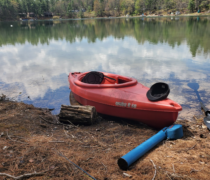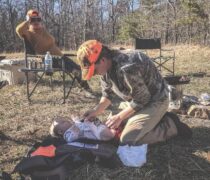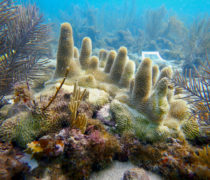The Problem

Chronic Wasting Disease (CWD) is the largest threat to cervid (deer, elk, moose, caribou) populations in North America today. It’s spreading across the United States at an alarming rate and draining the operating budgets of state wildlife agencies. The financial and emotional toll it takes on state agencies impacts so much more than just deer. Management and monitoring for all species from swallowtail butterflies to black bear suffer as resources are shifted to combating CWD. It has caused population declines in mule deer and white-tailed deer.
The Facts
CWD is caused and spread by prions. Prions are proteins that are found in most mammals and carry out various functions within the body. CWD prions are prions that have become misfolded and cause other normal prions to misfold as well. These misfolded prions buildup in the brain (and other parts of the body) and cannot be disposed of the way that normal prions typically would. They eventually cause lesions in the brain and an animal’s ability to function normally. Prions are not living like bacteria or similar infectious agents and thus cannot be ‘killed’. They are very difficult to destroy and can persist in the environment for years after being deposited there be an infected animal. CWD prions bind to soil (especially clay particles) and actually become more infectious to animals that may ingest or come into contact with them (mineral licks have been shown to be hotspots for transmission between deer).
Deer with CWD rarely look sick. The disease has a very long incubation period (time from infection to beginning of visible symptoms), sometimes as long as 18 or more months. This means a deer can be infected and shedding prions in to the environment for more than a year before they are visually discernable from an uninfected animal. Infected deer die relatively quickly after the onset of symptoms and die from other causes (vehicle collision, predation, hunter harvest) at higher rates than their uninfected peers so it’s not common to see them in the actual ‘wasting’ stages of the disease.
All deer that contract CWD will die. This disease is ALWAYS FATAL. The animal may not die from CWD directly because infected animals die at higher rates from other causes of mortality, but it will die.
The rate of spread is increasing:

Take Action
It’s critical that sportswomen and men understand how the disease is spread and take action to prevent it:

- Do get your deer tested for CWD
- Do be on the lookout for sick deer and report any that you see to your state wildlife agency
- Do talk to other hunters about the importance of stopping the spread and strategies they can employ to help
- Do support your state wildlife agency’s efforts to control the disease (targeted removals, bating bans, carcass movement restrictions, and population reductions in CWD management zones)
- Do express your concerns and desire for sound management of this disease to your state’s wildlife commissioners
- Don’t utilize bait or attractants that will cause deer to congregate and promote prion transmission
- Don’t move deer parts (aside from deboned meat) across state lines or across CWD management zone boundaries

Chronic Wasting Disease Chronicles Podcast Series
- Overview of the Disease and Associated Issues with Matt Dunfee
- Captive Cervids and Their Contribution to CWD with Dr. Colin Gillin
- How Hunters are Impacted by CWD and the Actions They Can Take with Kip Adams
- A state agency perspective on CWD with Dr. Kelly Straka of the Minnesota Dept. of Natural Resources
- The Chronic Wasting Disease Research and Management Act with Representative Ron Kind
- Now What? CWD is Here for the Foreseeable future – Living with and Managing that Reality with Matt Dunfee.
Additional Resources
CDC Guidelines Regarding Chronic Wasting Disease
Association of Fish and Wildlife Agencies CWD Best Management Practices
Map of Areas with CWD detected in wild or captive cervid population






